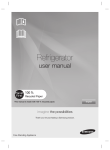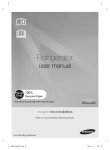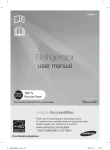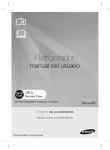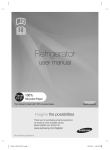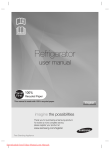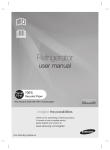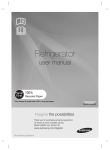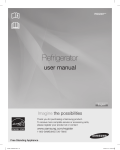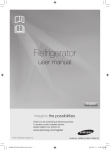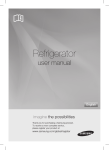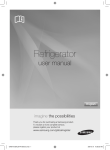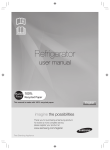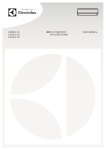Download Samsung RS30GKASL User Manual
Transcript
Refrigerator user manual This manual is made with 100% recycled paper. imagine the possibilities Thank you for purchasing a Samsung product. To receive a more complete service, please register your product at www.samsung.com/register Free Standing Appliance English safety information SAFETY INFORMATION • Before operating the appliance, please read this manual thoroughly and retain it at a safe place near the appliance for your future reference. • Use this appliance only for its intended purpose as described in this instruction manual. This appliance is not intended for use by persons (including children) with reduced physical, sensory or mental capabilities, or lack of experience and knowledge, unless they have been given supervision or instruction concerning use of the appliance by a person responsible for their safety. • Warnings and Important Safety Instructions in this manual do not cover all possible conditions and situations that may occur. It is your responsibility to use common sense, caution, and care when installing, maintaining, and operating your appliance. • Because these following operating instructions cover various models, the characteristics of your refrigerator may differ slightly from those described in this manual and not all warning signs may be applicable. If you have any questions or concerns, contact your nearest service center or find help and information online at www. samsung.com. Important safety symbols and precautions: WARNING CAUTION Hazards or unsafe practices that may result in severe personal injury or death. Hazards or unsafe practices that may result in minor personal injury or property damage. Do NOT attempt. Do NOT disassemble. Do NOT touch. Follow directions carefully. Unplug the power plug from the wall socket. Make sure the machine is grounded to prevent electric shock. Call the contact center for help. 02_ safety information Note. These warning signs are here to prevent injury to you and others. Please follow them carefully. After reading this section, keep it in a safe place for future reference. CE Notice This product has been determined to be in compliance with the Low Voltage Directive (2006/95/EC), the Electromagnetic Compatibility Directive (2004/108/EC) and the Eco-Design Directive(2009/125/EC) implemented by Regulation (EC) No 643/2009 of the European Union. WARNING SEVERE WARNING SIGNS FOR TRANSPORTATION AND SITE • When transporting and installing the appliance,care should be taken to ensure that no parts of the refrigerating circuit are damaged. • R600a or R134a is used as a refrigerant. Check the compressor label on the rear of the appliance or the rating label inside the refrigerator to see which refrigerant is used for your refrigerator. • When this product contains flammable gas (Refrigerant R600a), - Refrigerant leaking from the pipe work could ignite or cause an eye injury. If a leak is detected, avoid any naked flames or potential sources of ignition and air the room in which the appliance is standing for several minutes. - In order to avoid the creation of a flammable gas-air mixture if a leak in the refrigerating circuit occurs, the size of the room in which the appliance may be sited depends on the amount of refrigerant used. - Never start up an appliance showing any signs of damage. If in doubt, consult your dealer. The room where the refrigerator will be sited must be 1m³ in size for every 8g of R600a refrigerant inside the appliance. The amount of refrigerant in your particular appliance is shown on the identification plate inside the appliance. - If the appliance contains isobutane refrigerant (R600a), a natural gas with high environmental compatibility that is, however, also combustible. When transporting and installing the appliance, care should be taken to ensure that no parts of the refrigerating circuit are damaged. WARNING • • - • • • • - - • • - • • • SEVERE WARNING SIGNS FOR INSTALLATION • Do not install this appliance in a humid, oily or dusty location, in a location exposed to direct sunlight and water (rain drops). Deteriorated insulation of electrical parts may cause an electric shock or fire. Do not place this refrigerator in direct sunlight or expose to the heat from stoves, room heaters or other appliances. Do not plug several appliances into the same multiple power board. The refrigerator should always be plugged into its own individual electrical outlet which has a voltage rating that matched the rating plate. This provides the best performance and also prevents overloading house wiring circuits, which could cause a fire hazard from overheated wires. If the wall socket is loose, do not insert the power plug. There is a risk of electric shock or fire. Do not use a cord that shows cracks or abrasion damage along its length or at either end. Do not bend the power cord excessively or place heavy articles on it. Do not use aerosols near the refrigerator. Aerosols used near the refrigerator may cause an explosion or fire. Do not install this appliance in a location where gas may leak. This may result in an electric shock or fire. • The installation or any service of this appliance is recommended by a qualified technician or service company. Failing to do so may result in an electric shock, fire, explosion, problems with the product, or injury. This refrigerator must be properly installed and located in accordance with the manual before it is used. Connect the power plug in proper position with the cord hanging down. If you connect the power plug upside down, wire can get cut off and a cause fire or an electric shock. Make sure that the power plug is not squashed or damaged by the back of the refrigerator. When moving the refrigerator, be careful not to roll over or damage the power cord. This constitutes a fire hazard. The appliance must be positioned so that the plug is accessible after installation. • The refrigerator must be grounded. - You must ground the refrigerator to prevent any power leakages or electric shocks caused by current leakage from the refrigerator. • Never use gas pipes, telephone lines or other potential lightening rods as ground. - Improper use of the ground plug can result in an electric shock. • If the power cord is damaged, have it replaced immediately by the manufacturer or its service agent. • The fuse on the refrigerator must be changed by a qualified technician or service company. - Failing to do so may result in an electric shock or personal injury. CAUTION CAUTION SIGNS FOR INSTALLATION • Keep ventilation opening in the appliance enclosure or mounting structure clear of obstruction. • Allow the appliance to stand for 2 hours after installation. WARNING • - • • • • • • SEVERE WARNING SIGNS FOR USING • Do not insert the power plug with wet hands. Do not store articles on the top of the appliance. When you open or close the door, the articles may fall and cause a personal injury and/or material damage. Do not put items filled with water on the refrigerator. If spilled, there is a risk of fire or electric shock. Do not let children hang on the door. Failure to do so may cause serious personal injury. Do not leave the doors of the refrigerator open while the refrigerator is unattended and do not let children enter inside the refrigerator. Do not allow babies or children go inside the drawer. It can cause death from suffocation by entrapment or personal injury. Do not sit on the Freezer door. The door may be broken and cause a personal injury. To prevent children entrapment, you must reinstall safety information _03 • • • • • • • • the divider using provided screws after cleaning or other actions if you removed the divider from the drawer. Never put fingers or other objects into the dispenser hole. Failure to do so may cause personal injury or material damage. Do not store volatile or flammable substances such as benzene, thinner, alcohol, ether or LP gas in the refrigerator. The storage of any of such products may cause an explosion. Do not store low temperature-sensitive pharmaceutical products, scientific materials or other low temperature-sensitive products in the refrigerator. Products that require strict temperature controls must not be stored in the refrigerator. Do not place or use electrical appliance inside the refrigerator, unless they are of a type recommended by the manufacturer. Do not use a hair dryer to dry the inside of the refrigerator. Do not place a lighted candle in the refrigerator for removing bad odors. This may result in an electric shock or fire. Do not touch the inside walls of the freezer or products stored in the freezer with wet hands. This may cause frostbite. Do not use mechanical devices or any other means to accelerate the defrosting process, other than those recommended by the manufacturer. Do not damage the refrigerant circuit. nearest service center. Failing to do so may result in an electric or fire hazards. • If you experience difficulty when changing the light, contact service agent. • If the products is equipped with the LED Lamp, do not disassemble the Lamp Cover and LED Lamp by yourself. - Please contact your service agent. • If any dust or water is in the refrigerator, pull out power plug and contact your Samsung Electronics service center. - There is a risk of fire. - CAUTION • • - • • • • - • This product is intended only for the storage of food in a domestic environment. Bottles should be stored tightly together so that they do not fall out. In the event of a gas leak (such as propane gas, LP gas, etc.), ventilate immediately without touching the power plug. Do not touch the appliance or power cord. Do not use a ventilating fan. A spark may result in an explosion or fire. Use only the LED Lamps provided by manufacturer or service agent. Children should be supervised to ensure that they do not play with and/or climb into the appliance. • Do not disassemble or repair the refrigerator by yourself. You run a risk of causing a fire, malfunction and/ or personal injury. In case of malfunction, please contact your service agent. • If the appliance generates a strange noise, a burning or smell or smoke, unplug the power plug immediately and contact your 04_ safety information • - • • • • • CAUTION SIGNS FOR USING • To get best performance from the product, - Do not place foods too closely in front of the vents at the rear of the appliance as it can obstruct free air circulation in the refrigerator compartment. Wrap the food up properly or place it in airtight containers before putting it into the refrigerator. Do not put any newly introduced food for freezing near to already existing food. Do not place carbonated or fizzy drinks in the freezer compartment. Do not put bottles or glass containers in the freezer. When the contents freeze, the glass may break and cause personal injury and property damage. Do not change or modify the functionality of the refrigerator. Changes or modifications may result in a personal injury and/or property damage. Any changes or modifications performed by a 3rd party on this completed appliance are neither covered under Samsung warranty service, nor is Samsung responsible for safety issues and damages that result from 3rd party modifications. Do not block air holes. If the air holes are blocked, especially with a plastic bag, the refrigerator can be over cooled. If this cooling period lasts too long, the water filter may break and cause water leakage. Do not put any newly introduced food for freezing near to already existing food. Please observe maximum storage times and expiry dates of frozen goods. Fill the water tank, ice tray, water cubes only with potable water. Use only the ice-maker provided with the refrigerator. The water supply to this refrigerator must only be installed/connected by a suitably qualified person and connected to a potable water supply only. In order to operate the ice-maker properly, water pressure of 138~862kpa(1.4~8.8kgf/cm3) is required. • Do not spray volatile material such as insecticide onto the surface of the appliance. - As well as being harmful to humans, it may also result in an electric shock, fire or problems with the product. CAUTION • • • • - CAUTION SIGNS FOR CLEANING AND MAINTENANCE • Do not directly spray water inside or outside the refrigerator. There is a risk of fire or electric shock. Do not use or place any substances sensitive to temperature such as inflammable sprays, inflammable objects, dry ice, medicine, or chemicals near the refrigerator. Do not keep volatile or inflammable objects or substances (benzene, thinner, propane gas, etc.) in the refrigerator. This refrigerator is for storing food only. This may result in a fire or an explosion. Do not spray cleaning products directly on the display. Printed letters on the display may come off. Remove any foreign matter or dust from the power plug pins. But do not use a wet or damp cloth when cleaning the plug, remove any foreign material or dust from the power plug pins. Otherwise there is a risk of fire or electric shock. Never put fingers or other objects into the dispenser hole and ice chute. It may cause a personal injury or material damage. • Unplug the refrigerator before cleaning and performing maintenance. WARNING SEVERE WARNING SIGNS FOR DISPOSAL • Ensure that none of the pipes on the back of the appliance are damaged prior to disposal. • R600a or R134a is used as a refrigerant. Check the compressor label on the rear of the appliance or the rating label inside the refrigerator to see which refrigerant is used for your refrigerator. When this product contains flammable gas (Refrigerant R600a), contact your local authority in regard to safe disposal of this product. Cyclopentane is used as an insulation blowing gas. The gases in insulation material require special disposal procedure. Please contact your local authorities in regard to the environmentally safe disposal of this product. Ensure that none of the pipes on the back of the appliances are damaged prior to disposal. The pipes shall be broken in the open space. • When disposing of this product or other refrigerators, remove the door/door seals, door latch so that small children or animals cannot become trapped inside. Leave the shelves in place so that children may not easily climb inside. Children should be supervised to ensure that they do not play with the old appliance. • Please dispose of the packaging material for this product in an environmentally friendly manner. ADDITIONAL TIPS FOR PROPER USAGE • In the event of a power failure, call the local office of your Electricity Company and ask how long it is going to last. - Most power failures that are corrected within an hour or two will not affect your refrigerator temperatures. However, you should minimize the number of door openin gs while the power is off. - Should the power failure last more than 2 hours, remove all ice in the Ice Bucket. - Should the power failure last more than 24 hours, remove all frozen food. • If keys are provided with the refrigerator, the keys should be kept out of the reach of children and not be in the vicinity of the appliance. • The appliance might not operate consistently (possibility of temperature becoming too warm in the refrigerator) when sited for an extended period of time below the cold end of the range of temperature for which the refrigerating appliance is designed. • Do not store food which spoils easily at low temperature, such as bananas, melons. • Your appliance is frost free, which means there is no need to manually defrost your appliance, as this will be carried out automatically. • Temperature rise during defrosting can comply with ISO requirements. But if you want to prevent an undue rise in the temperature of the frozen food while defrosting the appliance, please wrap the frozen food up in several layers of newspaper. • Any increase in temperature of frozen food during defrosting can shorten its storage life. Saving Energy Tips - - Install the appliance in a cool, dry room with adequate ventilation. Ensure that it is not exposed to direct sunlight and never put it near a direct source of heat (radiator, for example). Never block any vents or grilles on the appliance. safety information _05 - - - - Allow warm food to cool down before placing it in the appliance. Put frozen food in the refrigerator to thaw. You can then use the low temperatures of the frozen products to cool food in the refrigerator. Do not keep the door of the appliance open for too long when putting food in or taking food out. The shorter time for which the door is open, the less ice will form in the freezer. Clean the rear of the refrigerator regularly. Dust increases energy consumption. Do not set temperature colder than necessary. Ensure sufficient air exhaust at the refrigerator base and at the back wall of the refrigerator. Do not cover air vent openings. Allow clearance to the right, left, back and top when installing. This will help reduce power consumption and keep your energy bills lower. contents SETTING UP YOUR SIDE-BY-SIDE REFRIGERATOR ……………………………………………………… 07 OPERATING THE SAMSUNG SIDE-BY-SIDE REFRIGERATOR …………………………………………… 13 TROUBLESHOOTING …………………………………………………………………………………………… 19 06_ safety information setting up your side-by-side refrigerator Congratulations on the purchase of your Samsung Side-By-Side Refrigerator. We hope you will enjoy the many state-of-the-art features and efficiencies that this new appliance has to offer. When moving your refrigerator To prevent floor damage, be sure the front levelling legs are in the up position (above the floor). Refer to ‘Levelling the refrigerator’ in this manual (page 9). To protect the finish of your flooring while you are installing the refrigerator, place a large section of the cardboard carton under the refrigerator where you are working. Selecting the best location for the refrigerator • Select a location with easy access to a water supply. • Select a location without direct exposure to sunlight. • Select a location with level (or nearly level) flooring. • Select a location with enough space for the refrigerator doors to open easily. See the diagram below. • Select a location that allows sufficient space to the right,left, back, and top for air circulation. See the diagram below. • Select a location that allows you to move the refrigerator easily if it needs maintenance or service. Leg Screw Driver CAUTION When installing, servicing or cleaning behind the refrigerator, be sure to pull the unit straight out and push back straight in after finishing. 50mm 50mm 1016mm 1308mm at least 6mm 974mm 1181mm at least 6mm 1727mm setting up _07 01 SETTING UP GETTING READY TO INSTALL THE REFRIGERATOR SETTING UP THE REFRIGERATOR Now that you have your new Refrigerator installed in place, you are ready to set up and enjoy the features and functions of the appliance. By completing the following steps, your Refrigerator should be fully operational. If not, first check the power supply and electricity source or try the troubleshooting section at the back of this user’s guide. If you have any further questions, contact your Samsung Electronics service center. 1. Place the Refrigerator in an appropriate location with reasonable clearance between the wall and the Refrigerator. Refer to installation instructions in this manual. 2. Once the Refrigerator is plugged in, make sure the interior light comes on when you open the doors. 3. Set the Temperature control to the coldest temperature and wait for an hour. The Freezer will get slightly chilled and the motor will run smoothly. 4. After powering the Refrigerator, it will take a few hours to reach the appropriate temperature. You can store food and drinks in the Refrigerator after the temperature is sufficiently cool. SETTING UP THE REFRIGERATOR DOORS If your entrance won’t allow the refrigerator to pass easily through it, you can remove the doors. Separating the Water Supply Line from the Refrigerator 1. Pull the two water lines (which are in the Fixer) out to the front. 08_ setting up 2. Remove two water lines (White one is for water and the other one is for ice) by pressing the coupler ( 1 ) and pulling the water line ( 2 ) away. 1 Make sure the color of the water lines match. 2 Reattaching the Water Supply Line 1. The Water Line must be fully Inserted to the center of transparent coupler to prevent water leakage from the dispenser. 2. Insert the 2clips in the install pack and check that it holds the line firmly. Center of transparent coupler clip A (1/4”) (6.35mm) Do not cut the water line. Gently separate it from the coupler. Removing the freezer door A few things to mention first. • Make sure that you lift the door straight up so the hinges are not bent or broken. • Be careful not to pinch the water tubing and wire harness on the door. • Place doors on a protected surface to prevent scratching or damage. 1. Remove a screw on the upper hinge cover 1 . With the door open, disengage the two locking tabs with a flat-head screw driver 2 and remove it while the lifting up the rear of the cover 3 , and then disconnect the wires by gently pulling them apart 4 . 1 Removing the Fridge Door 1. Remove a screw on the upper hinge cover 1 . With the door open, disengage the two locking tabs with a flat-head screw driver 2 and remove it while the lifting up the rear of the cover 3 , and then disconnect the wires by gently pulling them apart 4 . 1 4 3 4 2 2 2. Removing the FIXER HINGE ,and next take off the upper hinge. Be careful that the door does not fall on you as you are removing it. CAUTION 2. Removing the FIXER HINGE ,and next take off the upper hinge. Be careful that the door does not fall on you as you are removing it. Be sure to keep track of all parts you are removing. CAUTION 3. Next, remove the door from the lower hinge 5 by carefully lifting the door straight up 6 . 6 Be sure to keep track of all parts you are removing. 3. Remove the door from the lower hinge 5 by lifting 6 the door straight up 6 . 5 5 Reattaching the Fridge door CAUTION Be careful not to pinch the water tubing and wire harness on the door. Reattaching the freezer doors To reattach the freezer doors, replace parts in reverse order CAUTION To reattach the fridge doors, replace parts in reverse order. LEVELLING THE REFRIGERATOR Now that the doors are back on the refrigerator, you want to make sure the refrigerator is level so that you can make final adjustments. If the refrigerator is not level, it will not be possible to get the doors perfectly even. setting up _09 01 SETTING UP 3 When the Freezer part is lower than the Fridge part. Insert a flat-blade screwdriver into a slot on the Freezer Leg, then turn it clockwise. Screwdriver(-) Insert a flat-blade screwdriver into a slot on the Fridge Leg, then turn it clockwise. Screwdriver(-) Refer to the next section for the best way to make very minor adjustments to the doors. MAKING MINOR ADJUSTMENTS TO THE DOORS Remember, a level refrigerator is necessary for getting the doors perfectly even. If you need help, review the previous section on levelling the refrigerator. When the door of the fridge is higher than the freezer Insert a flat-blade screwdriver into a slot on the freezer leg, then turn it clockwise. When the door of the freezer is higher 10_ setting up Insert a flat-blade screwdriver into a slot on the fridge leg, then turn it clockwise. Freezer Leg When the Fridge part is lower than the Freezer part. Fridge Leg than the fridge CHECKING THE WATER DISPENSER LINE A water dispenser is one of the helpful features on your new Samsung Refrigerator. To help promote better health, the Samsung water filter removes unwanted particles from your water. However, it does not sterilize or destroy microorganisms. You may need to purchase a water purifying system to do that. In order for the ice maker to operate properly, a water pressure of 20~125 psi (pound per square inch) is required. Under normal conditions, a 170 cc (5.75 oz.) paper cup can be filled in 10 seconds. If the Refrigerator is installed in an area with low water pressure (below 20psi), you can install a booster pump to compensate for the low pressure. Make sure the water storage tank inside the Refrigerator is properly filled. To do this, press the water dispenser lever until the water runs from the water outlet. Water line installation kits are available at extra cost from your dealer. We recommend using a water supply kit that contains copper tubing. Check the accessory list below. Water line fixer and screws Pipe connector Water line Clip Connecting to the water supply line 1. First, shut off the main water supply line. 2. Locate the nearest cold, drinking water line. 3. Follow the Water Line Installation Instructions in the installation kit. CAUTION Close Main Water pipe CAUTION Before being used, the leakage in these places should be examined • Samsung Warranty does not cover WATER LINE INSTALLATION. • It’ll be done at customer’s charge unless the retail price includes installation cost. • Please contact Plumber or Authorized Installer for the installation if needed. • If Water leakage occurs due to improper installation, Please contact installer. No gap Close Main Water pipe 4. After connecting the water supply to the water filter, turn your main water supply back on and Dispense about 3L to clear and prime the water filter. Connecting the water line to the refrigerator 1. Remove the cap from water line on the unit and insert compression nut to the water line on the unit after disassembling from provided water line. 2. Connect both water line from the unit and water line in the kit 3. Tighten the compression nut onto the compression fitting. Be careful no gap between two items. 4. Turn water on and check for any leakage. Loosen a Remove cap No Leak 1. Slip the compression nut (A) through the supplied plastic tubing (A). 2. Tighten the compression nut (A) onto the 1/4” compression fitting. - If you are using copper tubing, slip the compression nut (B) (not included) and ferrule (not included) on copper tubing (not included) as shown. - If you are using plastic tubing (B), insert the molded end(Bulb) of the plastic tubing (B) into the compression fitting. Do not use without the molded end(Bulb) of the plastic tubing (B). 3. Tighten the compression nut (B) onto the compression fitting. Do not over-tighten the compression nut (B). 4. Turn water on and check for any leakage. CAUTION Water Line from unit No gap Water Line from Kit Only connect the water line to a drinkable water source. Only connect the water line to a drinkable water source. If you have to repair or disassemble the water line, cut off 1/4“ of the plastic tubing to make sure you get a snug, leak-free connection. setting up _11 01 SETTING UP The water line must be connected to the cold water pipe. If it is connected to the hot water pipe, it may cause the purifier to malfunction. If you have to repair or disassemble the water line, cut off 6.5mm of the plastic tubing to make sure you get a snug, leak-free connection. BEFORE USING ICEMAKER Remove - Hold the handle as shown in Figure1. Slightly pull up the bottom part. Take out the ice bucket slowly. Install - 4. Additional flushing may be required in some households. 5. Open the refrigerator door and make sure there are no water leaks coming from the water filter. Assemble the icemaker in the reverse order of disassembly. Push the bucket in firmly until you hear a clicking sound. If the bucket does not fit into its place, turn the gear handle on its back by 90 degrees and reinstall it again as shown in Figure 2. Ice Water Figure 1 A newly installed water filter cartridge may cause water to briefly spurt from the water dispenser. This is due to air getting into the line. It should pose no problem to operation. Figure 2 Before calling service Check the amount of water supplied - to the ice tray. - - Any sounds you hear when the ice maker dumps ice into the bucket are part of normal operation. Ice Chute If you don’t dispense ice for a Figure 3 long period of time, the ice may form clumps in the ice bucket. If ice clumps form, remove the remaining ice and empty the bucket. When ice does not come out, check for ice stuck in the chute and remove it. - When Ice Off blinks on the display panel, reinsert the bucket and/or make sure it’s installed properly. When the door is open, the Ice and water dispenser do not work. If you close the door hard, it may cause water spilling over the ice maker. To prevent dropping the ice bucket, use both hands when removing it. To prevent injury, be sure to clean up any ice or water that may have dropped on the floor. Do not let the children hang on the ice dispenser or on the bucket. They may get hurt. Be sure not to put your hand or any object into the ice chute. It may cause personal injury or damage mechanical parts. 1. Lift up the icemaker cover and gently pull it out. 2. When you press the Test button for 3 seconds, the ice cube container is filled with water from the water supply tap. Check to make sure the amount of water is correct (see the illustration below). If the water level is too low, the ice cubes will be small. This is a water pressure problem from within the main water pipes, not the refrigerator. 1 CAUTION - Removing residual matter inside the water supply line after installing filter. 1. Turn ON the main water supply. 2. Press the Water button and push the Dispenser Lever. 3. Flush 1 gallons of water through the filter before use. (Flush approximately 6 minutes.) This will clean the water supply system and remove air from the lines. 12_ setting up 2 Ice maker - Test button - It will take a few minutes for the water to reach the correct level after you push the Test button. Do not press the test button continuously when the tray is filled with ice or water. Water may overflow or ice jamming may occur. When the bucket is not installed, the ice maker does not work. When Ice Off blinks on the display panel, reinsert the bucket and/or make sure it’s installed properly. CAUTION - Check the water level operating the SAMSUNG sideby-side refrigerator USING THE CONTROL PANEL 4 2 5 3 6 10 7 (1) Energy Saver (2) Freezer (Hold 3 sec for Power Freeze) (3) Alarm / Hold 3 sec for Filter Reset Touching the Lighting button turns on the Dispenser LED lamp (under the display) in continuous mode so that it stays on continuously. The button also lights up. If you want the Dispenser lamp to come on only when some one uses the dispenser, press the Lighting button to turn the continuous mode off. Touch and hold this button for 3 seconds to switch the temperature units between °C and °F (5) Fridge Touch this button to set the Fridge temperature. You can set the temperature between 1°C and 7°C. Touch and hold the this button for 3 seconds to decrease the time needed to cool products in the Refrigerator. This can be helpful if you need to cool easily spoiled items quickly or if the temperature in the fridge has warmed dramatically (For example, if the door was left open). 9 8 Touching this button turns Energy Saver mode on and off. When you turn Energy Saver on, the Energy Saver icon lights up. Turn Energy Saver off, and the icon goes off. The Energy Saver function turns on automatically when power is supplied to the refrigerator. If condensation or water drops appear on the doors, turn the Energy Saver mode off. Touch this button to set the Freezer temperature. You can set the temperature between -14°C and -23°C. Touch and hold this button for 3 seconds to decrease the time needed to freeze products in the Freezer. It can be helpful if you need to freeze easily spoiled items quickly or if the temperature in the Freezer has warmed dramatically (For example, if the door was left open). (Hold 3 sec for Power Cool) (6) Ice Off (Hold 3 sec for child lock) This button serves two purposes: If you don’t want to make more ice, touch this button. Also, pressing and holding this button for 3 second locks the display panel and dispenser buttons so the buttons can not be used. The Child Lock icon lights up to indicate you’ve activated the Child Lock function. 1) To turn the door open alarm on and off. If the door alarm is set to On, an alarm beeps if any refrigerator door is left open for more than three minutes. The beeping stops when you close the door. The door alarm function is pre-set to On in the factory. You can turn it off by touching and then releasing this button. You can turn it back on in the same fashion. The icon lights up when the function is on. (7) Ice Type Touch this button to select your desired ice type. Cubed and crushed ice modes alternate each time you press the Ice Type button. Note that when you push the Ice Type button, you turn the Water dispenser off. 2) After you replace the water filter, Touch and hold this button for 3 seconds to reset the water filter life indicator. operating _13 02 OPERATING 1 (4) Lighting/ Hold 3 sec for C↔F (8) Water (9) Ice Off Touch this button to dispense water. Note that you cannot dispense water and ice simultaneously. The Water dispenser turns off when you press the Ice Type button. Controlling the Freezer temperature When you touch the Ice Off button ( ), the Ice Off icon lights and the Ice Maker stops making ice. We recommend you stop ice making if the following occur: - There is enough ice in the ice bucket. You want to save water and energy. Water is not being supplied to the refrigerator. If the ice maker function is ON, and the water line is not connected, there will be a water valve noise from back of the unit. Press the Ice Off (Hold 3sec for child lock) button ( ) for less than 3 seconds until the Ice Off ) illuminates. Indicator ( Recommend Temp (Freezer) : -20°C You can set the Freezer temperature between -23°C and -14°C to suit your particular needs. Touch the Freezer button repeatedly until the desired temperature is shown in the temperature display. The temperature will move 1°C degrees with each Touch as follows: -20°C → -21°C → -22°C → -23°C → -14°C → -15°C → -16°C → -17°C → -18°C → -19°C → -20°C. Keep in mind that foods such as ice cream can melt at -15°C. The temperature display will move sequentially from -23°C to -14°C. Controlling the fridge temperature If you do not touch any button, the freezer and fridge temperature indicator turn off in a few seconds. If you touch any button, the display lights up again. ( 10 ) Filter Water filter usage The Water Filter icon lights in red when you need to change the water filter. This occurs after you use about 300 gallons of water (which usually takes about 6 months). CONTROLLING THE TEMPERATURE Basic temperature of Freezer and Refrigerator Compartments The basic temperature and recommended temperatures of the Freezer and Refrigerator Compartments are -20°C and 3°C respectively. If the temperature of the Freezer or Refrigerator Compartments are too high or low, adjust the temperature manually. 14_ operating Recommend Temp (Fridge) : 3°C 3°C You can set the fridge temperature between 7°C and 1°C to suit your particular needs. Touch the Fridge button repeatedly until the desired temperature is shown in the temperature display. The temperature will move 1°C degrees with each touch as follows: 3°C → 2°C → 1°C → 7°C → 6°C → 5°C → 4°C → 3°C. The temperature control process for the Fridge works just like the Freezer process. Touch the Fridge button to set your desired temperature. After a few seconds, the Fridge will begin adjusting towards the newly set temperature. This will be reflected in the digital display. - - HOW TO USE THE DISPENSER Push the appropriate Ice Type button or the Water button to select what you want dispensed. • In case ice doesn’t come out, pull out the ice bucket and press the test button located on the right side of ice maker. • Do not press the test button continuously when the tray is filled with ice or water. Water may overflow or ice may jam the bucket. • When you press the Test button, you will hear the refrigerator chime (ding-dong). When the chime sounds, release the Test button. • The chime sounds automatically again to let you know the ice maker is working well. CAUTION If a power failure occurs, ice cubes may melt then freeze together when the power comes back on, causing the dispenser to be out of order. To prevent this problem, after a power failure, pull out the ice bucket and discard the residual ice or water. CAUTION After you dump the ice from the ice bucket, you should press the dispenser lever once with the ‘ICE CUBED’ or ‘CRUSHED’ function ON. NO ICE Select this if you want to turn ice maker off Press the Ice Type button to select the type of ice you want. Place your cup under the ice outlet and push gently against the dispenser lever. Make sure the glass is in line with the dispenser to prevent the ice from bouncing out. When you select Cubed Ice after using the Crushed Ice feature, a small amount of residual crushed ice might be produced. CAUTION Please wait 2 seconds before removing the glass under the dispenser to prevent spills. If the Refrigerator door opens, the Dispenser does not work. • Do not pull the lever out. You could damage or break the lever’s spring. • To clean the ice bin/bucket, wash with a mild detergent, rinse well, and dry thoroughly it. Do not use harsh or abrasive cleaners or solvents. The ice maker will make new ice faster after you return the ice bucket to the refrigerator. • Do not put your fingers, hands or any other unsuitable objects in the chute or ice-maker bucket. It may result in personal injury or material damage. • Use only the ice maker provided with the refrigerator. • The water supply to this refrigerator must be installed/connected by a suitably qualified person and connect to a potable water supply only. • For the the ice maker to operate properly, the water pressure must be between 20 and 125 psi. WARNING operating _15 02 OPERATING - - The temperature of the Freezer or Fridge may rise when you open the doors too frequently, or if a large amount of warm or hot food is placed inside. This may cause the digital display to blink. Once the Freezer and Fridge temperatures return to their normal set temperatures, the blinking will stop. If the blinking continues, you may need to “reset” the Refrigerator. Try unplugging the appliance, wait for around 10 minutes, and then plug the power cord back in. If there is a communication error between the Display and Main Controller, the Convertible Display light may blink. If the blinking continues for a long period of time, please contact a Samsung Electronics Service Center. • If you have a Ice-Maker Cover long vacation or business trip and won’t use the water or ice dispensers, close the water valve. - Otherwise, water leakage may occur. • When you have not Ice Bucket Ice Chute used the Ice maker for a while, or you have opened the Freezer door frequently, the Ice may stick together. If this has occurred, empty the ice bucket or break up the ice with a wood kitchen tool. Do not use sharp items such as knives or forks. • When the bucket is removed, there may still be some residual ice in the ice maker that the icemaker can release. When “Thaw” ends, food is in a half-frozen state, making it easy to cut for cooking. In addition, when “Thaw” ends, the CoolSelect Zone™ Drawer returns to the original “Chill” condition. To cancel this function mid-cycle, just press any button besides Thaw. • If ice does not dispense, pull CAUTION out the icemaker cover and press test button located on the ice maker. Test button • Do not press the test button continuously when the tray is filled with ice or water. Water may overflow or the ice may jam the icemaker or dispenser. You can use the “Quick Cool” operation with the CoolSelect Zone™ Drawer to quickly cool 1~3 canned beverages in about an hour. When the “Quick Cool” process ends, the CoolSelect Zone™ Drawer automatically returns to the previously set temperature. CAUTION Here are the approximate thawing times of meat and fish by weight (and based on a 25.4mm (1in.) thickness). This chart represents the total weight of food in the CoolSelect Zone™ Drawer. THAW TIME 4hours 6hours 10hours 12hours WEIGHT 363g (0.8Ib) 590g (1.3Ib) 771g (1.7Ib) 1000g (2.2Ib) Quick Cool To cancel this operation, press the Quick Cool button again and the CoolSelect Zone™ Drawer returns to the previously set temperature. Fresh USING THE COOLSELECT ZONE™ DRAWER The CoolSelect Zone™ Drawer is designed to make your busy life just a little bit easier. When “Cool” is selected, the temperature in the CoolSelect Zone™ Drawer will be the same as the overall temperature setting of the refrigerator. The drawer digital panel shows the same temperature as that of the refrigerator display panel. Since the “Cool” function mimics the refrigerator temperature, you have extra general storage space. Chill When “Chill” is selected, the temperature of the CoolSelect Zone™ Drawer is kept at -1°C, regardless of the overall temperature setting of the refrigerator. This feature also helps keep meat or fish fresh for longer. Thaw When “Thaw” is selected, warm and cold air is alternately blown into the CoolSelect Zone™ Drawer. Depending on the weight of the frozen food, you can select a 4 hrs, 6 hrs, 10 hrs, and 12 hrs thawing time. 16_ operating Depending on the size and thickness of the meat or fish, thawing times may vary. When “Thaw” is in operation, any items that you do not want affected should be moved out of the drawer. CLEANING THE REFRIGERATOR 5. Ice Bucket (Freezer) Do not use Benzene, Thinner or Clorox™, or WARNING car detergent to clean the Refrigerator. They may damage the surface of the appliance and can create a risk of fire. CAUTION Do not spray the refrigerator with water while it is plugged in, as it may cause an electric shock. Remove the Icemaker Bucket by lifting up and pulling it out slowly. • Grip the handle as shown in the figure. • Lift the low part slightly. • Take the ice bucket out slowly. REMOVING THE FREEZER/ FRIDGE ACCESSORIES You can break the cover and cause injury. Before removing any accessories, make sure that no food is in the way. Cleaning and rearranging the interior of the freezer is a snap. When possible, remove the food altogether to reduce the risk of accidents. 1. Shelves (Freezer/Fridge) Pull the shelf out as far as it goes and then lift up and remove it. CHANGING THE INTERIOR LIGHTS CAUTION Do not disassemble or replace the LED type Lighting. To change the LED Type Lighting, contact a Samsung service center. 2. DOOR BIN Remove the Door Bin by holding it with both hands, and then gently lift it up. 3. DRAWER Remove the Drawer by pulling it out and lifting it up slightly. 4. Drawer Cover Pull the cover out as far as it goes, and then lift up and remove it. TO IMPROVE THE COOLING PERFORMANCE If the cold air outlet is blocked by food items, the cold air cannot penetrate the entire compartment and will be unable to freeze the food efficiently which results in a degraded cooling performance. In particular, there is load limit at the top of the freezing compartment. Please do not put food items above this limit. Cold air outlet Load limit in the freezing compartment operating _17 02 OPERATING Do not use excessive force when removing the drawer cover. CHANGING THE WATER FILTER WARNING To reduce risk of water damage to your property DO NOT use generic brands of water filers in your SAMSUNG Refrigerator. USE ONLY SAMSUNG BRAND WATER FILTERS. SAMSUNG is not legally responsible for any damage, including, but not limited to property damage caused by water leakage from the use of a generic water filter. SAMSUNG Refrigerators are designed to work ONLY WITH SAMSUNG Water Filters. The “Filter Indicator” light lets you know when it is time to change your water filter cartridge. To give you preparation time to get a new filter, the red light will come on just before the capacity of the current filter runs out. Changing the filter on time provides you with the freshest, cleanest water from your fridge. To change the water filter, follow these steps: 1. Turn the water filter 90˚ counter-clockwise. water filter. The color of indicator changes from red to light off. A newly installed water filter cartridge may cause water to briefly spurt from the water dispenser. This is due to air getting into the line. It should pose no problem to operation. Removing residual matter inside the water supply line after installing a new filter 1. Press the Water button, and then push the Dispenser Lever with a cup or glass. 2. Flush 1 gallon of water through the filter, one cup or glass at a time. (Flush approximately 6 minutes.) This will clean the water supply system and remove air from the lines. - Additional flushing may be required in some households. 3. Open the refrigerator door and make sure there are no water leaks coming from the water filter. Reverse Osmosis Water Supply IMPORTANT : The pressure of the water supply coming out of a reverse osmosis system going to the water inlet valve of the refrigerator needs to be between 35 and 120 psi (241 and 827 kPa). 2. Pull the water filter from the filter housing. 3. Insert new water filter inside the filter housing. 4. Turn the new water filter 90˚ clockwise. If a reverse osmosis water filtration system is connected to your cold water supply, the water pressure to the reverse osmosis system needs to be a minimum of 40 to 60 psi (276 to 414 kPa.) If the water pressure to the reverse osmosis system is less than 40 to 60 psi (276 to 414 kPa): • Check to see whether the sediment filter in the reverse osmosis system is blocked. Replace the filter if necessary. • Allow the storage tank on the reverse osmosis system to refill after heavy usage. • If your refrigerator has a water filter, it may further reduce the water pressure when used in conjunction with a reverse osmosis system. Remove the water filter. If you have questions about your water pressure, call a licensed, qualified plumber. Ordering replacement filters To order more water filter cartridges, contact your authorized Samsung dealer. 5. Press the “Alarm/hold 3 sec for Filter Reset” button ( ) for about 3 seconds to reset the 18_ operating troubleshooting SOLUTION The refrigerator does not work at all or it does not chill sufficiently. • • The food in the fridge is frozen. • You hear unusual noises or sounds. • • • • • • • • The front corners of the appliance are hot and condensation is occurring. • Ice is not dispensing. • • • • • • Check that the power plug is properly connected. Is the temperature control on the display panel set to the correct temperature? Try setting it to a lower temperature. Is the refrigerator in direct sunlight or located too near a heat source? Is the back of the refrigerator too close to the wall and therefore keeping air from circulating? Is the temperature control on the display panel set to the correct temperature? Try setting it to a warmer temperature. Is the temperature in the room very low? Did you store the food with a high water content in the coldest part of the fridge? Check that the refrigerator is level and stable. Is the back of the refrigerator too close to the wall and therefore keeping air from circulating? Was anything dropped behind or under the refrigerator? A “ticking” sound is heard from inside the refrigerator. This is normal and occurs because various accessories are contracting or expanding in relation to the temperature of the refrigerator interior. Some heat is normal as anti-condensators are installed in the front corners of the refrigerator to prevent condensation. Is the refrigerator door ajar? Condensation can occur when you leave the door open for a long time. Did you wait at least 12 hours after installation of the water supply line before making ice? Is the water line connected and the shut-off valve open? Did you manually stop the ice making function? Make sure Ice Type is set to Cubed or Crushed. Is there any ice blocked within the ice maker bucket? Is the freezer temperature too warm? Try setting the freezer temperature lower. You can hear water bubbling in the refrigerator. • This is normal. The bubbling comes from the refrigerant coolant liquid circulating through the refrigerator. There is a bad smell in the refrigerator. • • • Has a food item spoiled? Make sure that strong smelling food (for example, fish) is wrapped so that it is airtight. Clean out your freezer periodically and throw away any spoiled or suspect food. Frost forms on the walls of the freezer. • • • Is the air vent blocked? Remove any obstructions so air can circulate freely. Allow sufficient space between the foods stored for efficient air circulation. Is the freezer door closed properly? Water dispenser is not functioning. • • Is the water line connected and the shut-off valve open? Has the water supply line tubing been crushed or kinked? Make sure the tubing is free and clear of any obstruction. Is the water tank frozen because the refrigerator temperature is too low? Try selecting a warmer setting on the main display panel. • troubleshooting _19 03 TROUBLESHOOTING PROBLEM Ambient Room Temperature Limits This refrigerator is designed to operate in ambient temperatures specified by its temperature class marked on the rating plate. Class Symbol Extended Temperate SN Ambient Temperature range(°C) +10 to +32 Temperate N +16 to +32 Subtropical ST +16 to +38 Tropical T +16 to +43 Internal temperatures may be affected by such factors as the location of the fridge/freezer, ambient temperature and the frequency with which you open the door. Adjust the temperature as required to compensate for these factors. Correct Disposal of This Product (Waste Electrical & Electronic Equipment) English (Applicable in the European Union and other European countries with separate collection systems) This marking on the product, accessories or literature indicates that the product and its electronic accessories (e.g. charger, headset, USB cable) should not be disposed of with other household waste at the end of their working life. To prevent possible harm to the environment or human health from uncontrolled waste disposal, please separate these items from other types of waste and recycle them responsibly to promote the sustainable reuse of material resources. Household users should contact either the retailer where they purchased this product, or their local government office, for details of where and how they can take these items for environmentally safe recycling. Business users should contact their supplier and check the terms and conditions of the purchase contract. This product and its electronic accessories should not be mixed with other commercial wastes for disposal. Contact SAMSUNG WORLD WIDE If you have any questions or comments relating to Samsung products, please contact the SAMSUNG customer care center. COUNTRY CALL Web site AUSTRALIA 1300 362 603 www.samsung.com/au COLOMBIA 01-8000112112 www.samsung.com/co 0818 717 100 www.samsung.com/ie (852) 3698-4698 www.samsung.com/hk www.samsung.com/hk_en/ 3030 8282, 1-800-3000-8282 www.samsung.com/in 1800-88-9999 www.samsung.com/my EIRE HONG KONG INDIA MALAYSIA NEW ZEALAND 0800 SAMSUNG (726-7864) www.samsung.com/nz 800-7267 www.samsung.com/latin PHILIPPINES 1800-10-SAMSUNG (726-7864) www.samsung.com/ph SINGAPORE 1800-SAMSUNG (726-7864) www.samsung.com SOUTH AFRICA 0860-SAMSUNG (726-7864 ) www.samsung.com U.K 0330 SAMSUNG (726-7864) www.samsung.com 1 800 588 889 www.samsung.com PANAMA VIETNAM Code No. DA68-02502G REV(0.4)




















